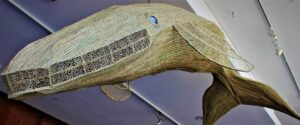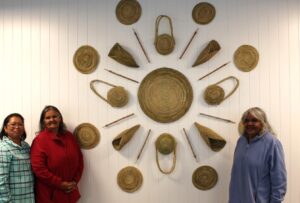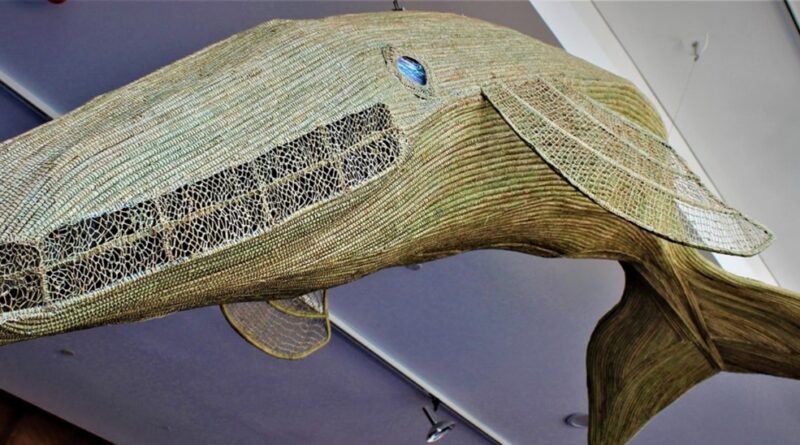Reclaiming Cultural Heritage: An Art-Based Exploration of Indigenous Artifacts and Their Meanings
Reclaiming Cultural Heritage: An Art-Based Exploration of Indigenous Artifacts and Their Meanings
Jelina Haines, Aunty Ellen Trevorrow and Aunty Millie Rigney
The intricate interaction between artefacts and human practices unveils profound cultural significance, prompting a reevaluation of dominant narratives and emphasizing the enduring relevance of traditional practices and meanings in a contemporary context (Anheier et al., 2011).
This narrative continues my doctoral research titled Researching the Knowledge Journey Practices of Indigenous Elders Relevant to the Younger Generation: A Community-based Participatory Study (Haines, 2021). The research was meticulously integrated with a community-based approach, incorporating ethical protocols within the established cultural context. It explores how traditional stories and cultural practices can bring to light and revive the cultural significance of traditional artefacts to contemporary art (Figures 1 and 2). Ngarrindjeri Artists and storytellers use weaving and storytelling approaches to creatively explore selected totems or ngaitye in the Ngarrindjeri language, bridging the gap between the past and present of cultural knowledge. According to research, cultural objects and practices are assessed and processed through a multisensory storytelling approach, which can enhance emotional strength and comfort (Seitz et al., 2023). This is of paramount importance for cultural survival and preservation management of artefacts. Hence, cultural artefacts can silently convey history, tradition, and community beliefs without words. However, not all of this knowledge is immediately visible. Much of it is embedded in the “invisible”—the stories behind the artefact’s creation, the cultural practices it represents, and the skills and knowledge embodied within its form.
—Much of cultural knowledge is embedded in the "invisible"—the stories behind the artefact's creation—
My research project involves utilizing video recordings to preserve the narratives of the Ngarrindjeri Storytellers, offering valuable insights into their experiences, knowledge, and enduring connection to the land and country. Throughout this study, innovative frameworks, models, and data collection tools were devised to facilitate inclusive dialogue and mutual engagement, with a focus on fostering mutual respect, trust, reciprocity, and meeting the needs of the Storytellers (Haines, 2021, p. 294). The main aim of the research was to formulate a conceptual model known as the Ngarrindjeri Knowledge Journey (NKJ), intended to serve as a transferrable and adaptable resource in other Indigenous communities (Haines, 2021, pp. 307 -323).
The traditional art of Ngarrindjeri weaving is a powerful medium for illuminating obscured knowledge, offering a unique and culturally significant perspective that brings to life elements often unseen. Two exemplary woven artworks, meticulously crafted by skilled artisans, stand as potent tools for community engagement and cultural revitalization, showcasing the transformative potential of art-based approaches in reclaiming and reinterpreting traditional heritage. One such example is the captivating narrative of Kondoli: the Keeper of Fire, a remarkable piece that intricately weaves together the ancestral wisdom and the enduring spirit of the Ngarrindjeri people (Figure 1; Haines, 2021, p. 287).

The sculpture Kondoli: the Keeper of Fire is a remarkable artistic creation representing a southern right whale skillfully crafted entirely from freshwater rushes. Kondoli, also known as the Whale, is a significant figure in the Ngarrindjeri dreaming story as a strong man with the extraordinary ability to create fire. This magnificent and detailed work of art, measuring more than four meters in length, is a testament to the dedication and skill of the artists involved. The intricately woven fins, mouth, and eyes are delicately crafted using the open-weaved lace technique, illustrating the precision and artistry involved in the creation of this sculpture. It serves as a powerful testament to the technique, adaptability, and endurance of Ngarrindjeri weaving, which plays a crucial role in preserving Ngarrindjeri cultural practices and stories for posterity.
The woven sculpture of Kondoli is a powerful symbol of resilience and hope and holds significant cultural importance for the Ngarrindjeri people. Now on a permanent display at the South Australian Museum (SAM), it is a testament to the enduring spirit of the Indigenous people, which has withstood the test of time and adversity. The video is publicly available courtesy of SAM via https://www.youtube.com/watch?v=4Iucvkad86c
Kondoli is now permanently publicly displayed at the South Australian Museum.
The second example is Nanggi (Sun) yailparar (rays) lakun (weaving) artwork. Nanggi Yailparar Lakun (Sunrays weaving) is a part of the U City Arts Project, a collaborative initiative between Uniting Communities and Guildhouse to commission artworks for the new Uniting Communities City building. This stunning sculpture, created by a renowned Australian artist, represents the profound concept of illumination permeating the voids in Australia’s colonial history (Figure 2).

The sculpture was designed to capture the essence of enlightenment and the idea that there is always light and hope to shine through, even in the darkest moments of history, as it narrates (Haines, 2021, pp. 284-285).
The sculpture’s intricate use of light and shadow is a powerful symbol of resilience and the enduring spirit of the Australian people. Despite the nation’s tumultuous past, the concept of Nanggi yailparar lakun, originating from the Indigenous traditions of the region, serves as a powerful analogy for the enduring inner light within each individual. It symbolizes the resilience and strength that guides us through the challenges and triumphs of life, akin to a steadfast candle that illuminates our paths and leads us through the diverse and intricate journeys we undertake. This concept is deeply rooted in the community’s cultural fabric, representing the collective spirit and unwavering determination to navigate through adversity with hope and fortitude. The concept represents the importance of Uniting Communities’ service to the Ngarrindjeri people, where family and extended community are an interconnected system of knowledge. The artwork, a beautiful and thought-provoking piece, serves as a powerful tribute to the ongoing journey of reconciliation between Indigenous and non-Indigenous people. It symbolizes the collective commitment to bridge knowledge gaps through collaborative efforts, aiming to make a tangible difference by providing essential support to marginalized community members. This artwork serves as a poignant reminder of the importance of unity, understanding, and empowerment in creating a more inclusive and supportive society for all.
The two artworks elucidate the narratives, symbolism, and traditions that have been transmitted through eight generations of Ngarrindjeri cultural weavers. Additionally, both artworks serve to foster cross-cultural understanding and uphold the preservation of their heritage.
Through the integration of art practices and video ethnography, we can gain a comprehensive understanding of the tangible and intangible knowledge associated with weaving. This understanding provides invaluable insights into the cultural and historical significance of these communities. The two sculptures serve as a testament to the capacity of art practices to unveil the concealed aspects of culture and the wisdom they encapsulate. Art serves as a means to deepen our comprehension of Indigenous cultural heritage while fostering collaborative learning and critical thinking and promoting mutual and intercultural understanding.
Cite this article in APA as: Haines, J., Trevorrow, E., & Rigney, M. Reclaiming cultural heritage: An art-based exploration of indigenous artifacts and their meanings. (2024, October 21). Information Matters, Vol. 4, Issue 10. https://informationmatters.org/2024/10/reclaiming-cultural-heritage-an-art-based-exploration-of-indigenous-artifacts-and-their-meanings/
Author
-
Dr. Jelina Haines is a distinguished researcher and educator with a multidisciplinary background spanning computer science, business, arts, and education. Her academic journey includes a PhD from the University of South Australia, alongside Master's degrees and postgraduate studies in relevant fields. A recognized leader in her field, Dr. Haines has published extensively, delivered 18 keynote addresses internationally, and serves as a Policy Advocate for Catalyst 2030 Australasia. Her research, recognized with prestigious awards like the ASIS&T ProQuest Doctoral Dissertation Award, focuses on the intersection of technology, culture, and community, particularly Indigenous knowledge preservation. Dr. Haines's collaborative approach emphasizes the power of storytelling, working closely with Elders to bring cultural narratives to life and foster deeper understanding across communities.
View all posts Policy Advocacy Lead





